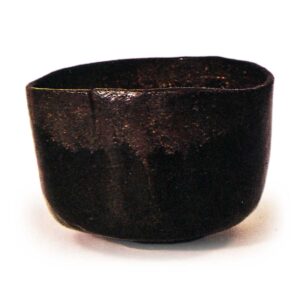
Artist of the Momoyama and early Edo periods, born in 1558. His family name was Hon’ami, and he was also known as Jiro Saburo, Jidusai, Tokuyusai, and Daikyoan. He was the eldest son of Hon’ami VIII Koji Myo, the swordsmith of the Muromachi Shogunate. He later established the Hon’ami branch of the family with his father and lived in Hon’amigatsuji, Kyoto, where he engaged in the family business of sword appraisal and polishing and cleaning. In addition to his family business, he was also skilled in the arts of painting, calligraphy, calligraphy, tea ceremony, incense, flower arrangement, pottery, and lacquerware, and he was a comprehensive artist for many years to come. In 1615, Ieyasu granted him the land of Takagamine in the northern part of Kyoto, and he established Koetsu’s art village with fifty-five households, including his family’s various craftsmen. He studied tea ceremony with Oribe Furuta and became acquainted with Enshu Kobori and Sotan Sen. His masterpieces are now regarded as treasures under the name of Koetsu’s five types, seven types, and ten works. He himself wrote in his “Hon’ami Gyojoki” about his production, “I think that if I do not improve in everything, I will never learn the secrets of the art, but it is strange that I have not learned the way. Regarding tea, he says, “Even if you like tea, you should not be concerned with rare vessels, but leave the utensils to others, and if you have too much to offer, you should use the utensils that suit you best. Koetsu was also famous for his calligraphy, and many of his works are said to be collaborations with Sotatsu’s underpainting, and he published the Saga version of chants in collaboration with his disciple Kadokura Soan. The decorative painting style known today as the Korin school actually originated with Koetsu. Koetsu often traveled back and forth to Kanazawa, especially from Kaga Maeda domain, where he was granted 200 koku of gold. Among the biographical materials on Koetsu are “Hon’ami Gyojoki” written by his adopted son Mitsusa and grandson Mitsuho, and “Nigai Kusa” written by his nephew Mitsumasu’s son Haiya Shaoyasu. His grandson, Mitsuho, surnamed Kakaisai (1682-, died in Tenwa 2), is also renowned for his pottery. The Koetsu-kai, or Koetsukai, was formed in 1915 by business people who admired Koetsu’s legacy and art, and since then a tea ceremony has been held every November at Koetsu-ji Temple in Takagamine.



